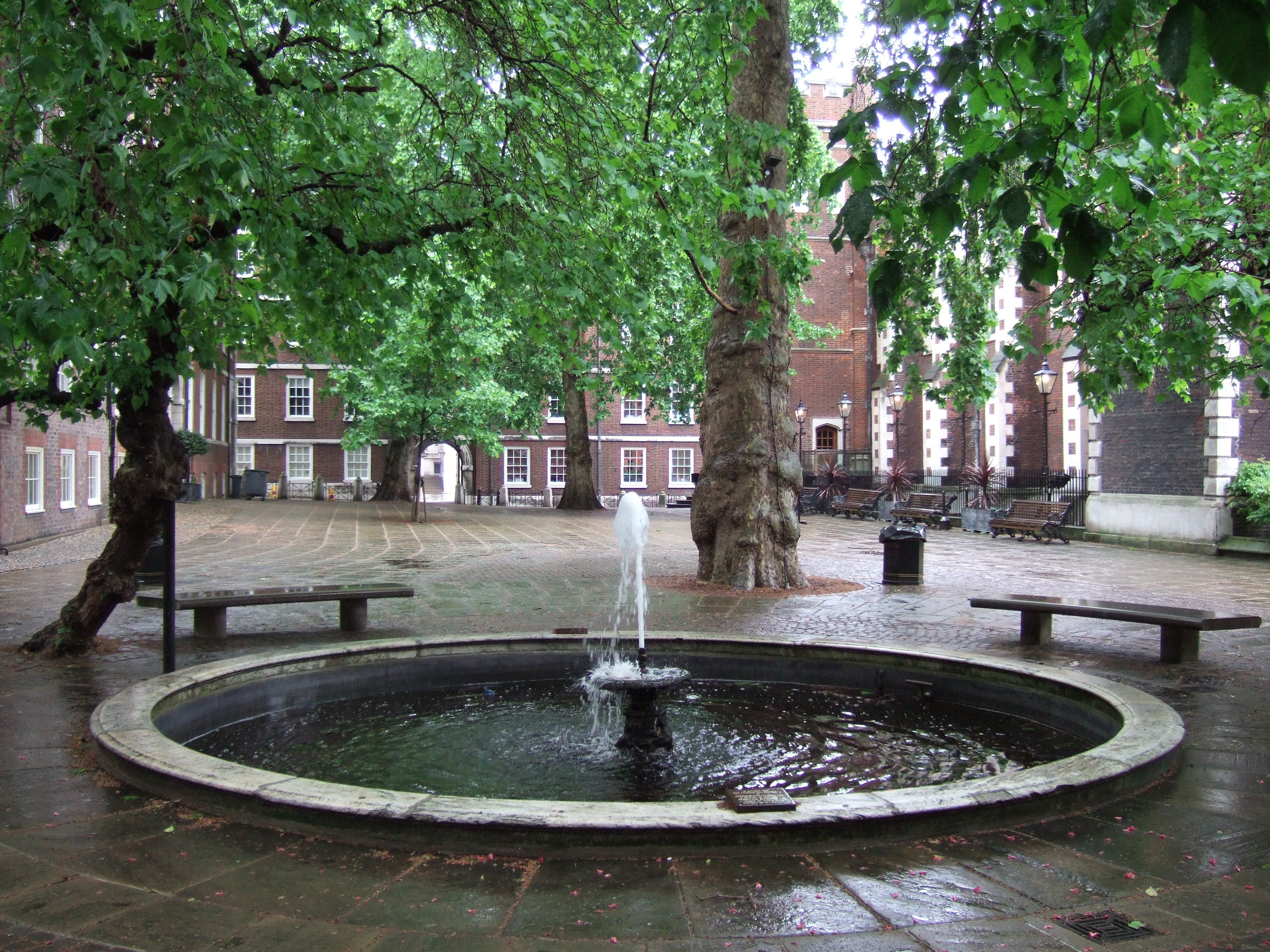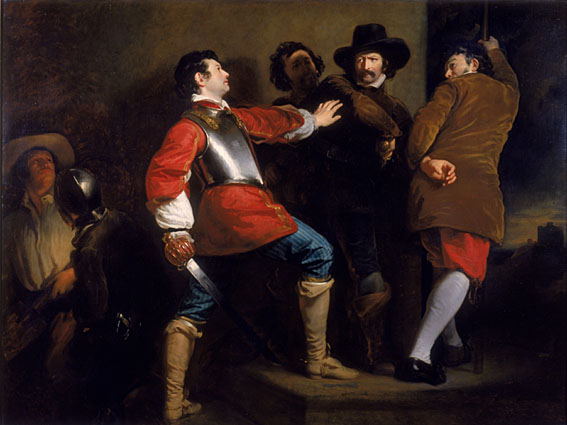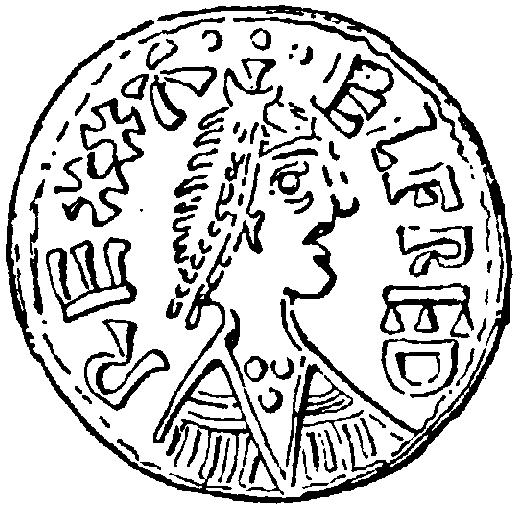|
Hilderston, West Lothian
Hilderston or Hilderstone in West Lothian, Scotland, was the site of the discovery of a vein of silver in 1606 and a mining operation that attracted international interest. King James used rumours of a silver bonanza to leverage a loan in the City of London. He took over the mine works, an act sometimes regarded as an example of nationalization. The enterprise may have inspired a satirical stage play. On 8 May 1608 work commenced under royal supervision. Miners from Cornwall and Germany were employed in the works. Hilderston is near Cairnpapple Hill in the Bathgate Hills. Contemporary descriptions of the silver ore seem to refer to native silver, mercury amalgams, arsenical content, and nickeline, found in "native silver bearing carbonate veins". The God's Blessing shaft Silver was discovered on lands at Hilderston in June 1606. The find was attributed to a collier called Sandy Maund by another prospector Stephen Atkinson. The landowner was the King's Advocate, Sir Thomas H ... [...More Info...] [...Related Items...] OR: [Wikipedia] [Google] [Baidu] |
West Lothian
West Lothian ( sco, Wast Lowden; gd, Lodainn an Iar) is one of the 32 council areas of Scotland, and was one of its historic counties. The county was called Linlithgowshire until 1925. The historic county was bounded geographically by the Avon to the west and the Almond to the east. The modern council area occupies a larger area than the historic county. It was reshaped following local government reforms in 1975: some areas in the west were transferred to Falkirk; some areas in the east were transferred to Edinburgh; and some areas that had formerly been part of in Midlothian were added to West Lothian. West Lothian lies on the southern shore of the Firth of Forth and is predominantly rural, though there were extensive coal, iron, and shale oil mining operations in the 19th and 20th centuries. These created distinctive red-spoil heaps (locally known as " bings") throughout the council area. The old county town was the royal burgh of Linlithgow, but the largest town (and t ... [...More Info...] [...Related Items...] OR: [Wikipedia] [Google] [Baidu] |
Robert Cecil, 1st Earl Of Salisbury
Robert Cecil, 1st Earl of Salisbury, (1 June 156324 May 1612), was an English statesman noted for his direction of the government during the Union of the Crowns, as Tudor England gave way to Stuart rule (1603). Lord Salisbury served as the Secretary of State of England (1596–1612) and Lord High Treasurer (1608–1612), succeeding his father as Queen Elizabeth I's Lord Privy Seal and remaining in power during the first nine years of King James I's reign until his own death. The principal discoverer of the Gunpowder Plot of 1605, Robert Cecil remains a controversial historic figure as it is still debated at what point he first learned of the plot and to what extent he acted as an '' agent provocateur''. Early life and family Cecil (created Earl of Salisbury in 1605) was the younger son of William Cecil, 1st Baron Burghley by his second wife, Mildred Cooke, eldest daughter of Sir Anthony Cooke of Gidea Hall, Gidea, Essex. His elder half-brother was Thomas Cecil, 1 ... [...More Info...] [...Related Items...] OR: [Wikipedia] [Google] [Baidu] |
Lord Chancellor Of Scotland
The Lord Chancellor of Scotland, formally the Lord High Chancellor, was a Great Officer of State in the Kingdom of Scotland. Holders of the office are known from 1123 onwards, but its duties were occasionally performed by an official of lower status with the title of Keeper of the Great Seal. From the 15th century, the Chancellor was normally a Bishop or a Peer. At the Union, the Lord Keeper of the Great Seal of England became the first Lord High Chancellor of Great Britain, but the Earl of Seafield continued as Lord Chancellor of Scotland until 1708. He was re-appointed in 1713 and sat as an Extraordinary Lord of Session in that capacity until his death in 1730. List of Lords Chancellors of Scotland David I * 1124-1126: John Capellanus * 1126-1143: Herbert of Selkirk * bef.1143-1145: Edward, Bishop of Aberdeen * c.1147–c.1150: William Cumin * bef.1150-1153: Walter, possibly Walter fitz Alan Malcolm IV * 1153–1165: Enguerrand, Bishop of Glasgow William I * 1165 ... [...More Info...] [...Related Items...] OR: [Wikipedia] [Google] [Baidu] |
Sir John Arnot
John Arnot of Birswick (Orkney) (1530–1616) was a 16th-century Scottish merchant and landowner who served as Lord Provost of Edinburgh from 1587 to 1591 and from 1608 to death. He was Deputy Treasurer to King James VI. Career He was born in 1530 the son of William Arnot and his wife, Margaret Wallace. At the Reformation of 1560 the family converted to Protestantism. In August 1574 he submitted a petition to the English ambassador Henry Killigrew who was returning to London. He wanted redress for a cargo of textiles from Flanders. He was tricked by English pirates off Great Yarmouth, led by William Hudson of Colchester, who pretended to be searching for pirates. They stole his own clothes as well as a stock of fabric including velvets, the most costly being a figured black velvet, gold and silver thread, silk thread, gold and silver passementerie, and various silk chamlets and Spanish taffetas. Arnot mentioned that he had talked with Killigrew at Glamis Castle, but wa ... [...More Info...] [...Related Items...] OR: [Wikipedia] [Google] [Baidu] |
Guy Fawkes
Guy Fawkes (; 13 April 1570 – 31 January 1606), also known as Guido Fawkes while fighting for the Spanish, was a member of a group of provincial English Catholics involved in the failed Gunpowder Plot of 1605. He was born and educated in York; his father died when Fawkes was eight years old, after which his mother married a recusant Catholic. Fawkes converted to Catholicism and left for mainland Europe, where he fought for Catholic Spain in the Eighty Years' War against Protestant Dutch reformers in the Low Countries. He travelled to Spain to seek support for a Catholic rebellion in England without success. He later met Thomas Wintour, with whom he returned to England. Wintour introduced him to Robert Catesby, who planned to assassinate and restore a Catholic monarch to the throne. The plotters leased an undercroft beneath the House of Lords; Fawkes was placed in charge of the gunpowder that they stockpiled there. The authorities were prompted by an anonymous lett ... [...More Info...] [...Related Items...] OR: [Wikipedia] [Google] [Baidu] |
Middle Temple
The Honourable Society of the Middle Temple, commonly known simply as Middle Temple, is one of the four Inns of Court exclusively entitled to call their members to the English Bar as barristers, the others being the Inner Temple, Gray's Inn and Lincoln's Inn. It is located in the wider Temple area of London, near the Royal Courts of Justice, and within the City of London. History During the 12th and early 13th centuries the law was taught, in the City of London, primarily by the clergy. But a papal bull in 1218 prohibited the clergy from practising in the secular courts (where the English common law system operated, as opposed to the Roman civil law favoured by the Church). As a result, law began to be practised and taught by laymen instead of by clerics. To protect their schools from competition, first Henry II and later Henry III issued proclamations prohibiting the teaching of the civil law within the City of London. The common law lawyers migrated to the hamlet of ... [...More Info...] [...Related Items...] OR: [Wikipedia] [Google] [Baidu] |
Edmund Doubleday
Edmund Doubleday (died December 1620) was an English vintner, lawyer, office-holder and politician who sat in the House of Commons in 1614. He was jointly responsible for the capture of Guy Fawkes in the Gunpowder Plot. Doubleday was acting as a scrivener and public notary by 1587 and then studied law at Middle Temple. He was active at the parish of St Margaret's, Westminster where he signed parish accounts from 1590. He was overseer of the poor in 1590. By the 1590s he had acquired leases of several properties from Westminster Abbey and marriages to wealthy widows brought him various property in Westminster which included the Saracens Head on King Street. In 1591 he was assigned half the lease of Ebury Manor by Thomas Knyvet with whom he was subsequently involved in various activities. From 1592 to 1595 he was High Constable of Westminster. Doubleday was built for law enforcement, being described in ''Anglorum Speculumas'' as "a man of great stature, valour, gravity and activi ... [...More Info...] [...Related Items...] OR: [Wikipedia] [Google] [Baidu] |
Royal Mint
The Royal Mint is the United Kingdom's oldest company and the official maker of British coins. Operating under the legal name The Royal Mint Limited, it is a limited company that is wholly owned by His Majesty's Treasury and is under an exclusive contract to supply the nation's coinage. As well as minting circulating coins for the UK and international markets, The Royal Mint is a leading provider of precious metal products. The Royal Mint was historically part of a series of mints that became centralised to produce coins for the Kingdom of England, all of Great Britain, the United Kingdom, and nations across the Commonwealth. The Royal Mint operated within the Tower of London for several hundred years before moving to what is now called Royal Mint Court, where it remained until the 1960s. As Britain followed the rest of the world in decimalising its currency, the Mint moved from London to a new 38-acre (15 ha) plant in Llantrisant, Glamorgan, Wales, where it has remained s ... [...More Info...] [...Related Items...] OR: [Wikipedia] [Google] [Baidu] |
James VI And I
James VI and I (James Charles Stuart; 19 June 1566 – 27 March 1625) was King of Scotland as James VI from 24 July 1567 and King of England and Ireland as James I from the union of the Scottish and English crowns on 24 March 1603 until his death in 1625. The kingdoms of Scotland and England were individual sovereign states, with their own parliaments, judiciaries, and laws, though both were ruled by James in personal union. James was the son of Mary, Queen of Scots, and a great-great-grandson of Henry VII, King of England and Lord of Ireland, and thus a potential successor to all three thrones. He succeeded to the Scottish throne at the age of thirteen months, after his mother was compelled to abdicate in his favour. Four different regents governed during his minority, which ended officially in 1578, though he did not gain full control of his government until 1583. In 1603, he succeeded Elizabeth I, the last Tudor monarch of England and Ireland, who died childless. H ... [...More Info...] [...Related Items...] OR: [Wikipedia] [Google] [Baidu] |
Marcus Gheeraerts The Younger Alexander Seton 1st Earl Of Dunfermline
Marcus, Markus, Márkus or Mărcuș may refer to: * Marcus (name), a masculine given name * Marcus (praenomen), a Roman personal name Places * Marcus, a main belt asteroid, also known as (369088) Marcus 2008 GG44 * Mărcuş, a village in Dobârlău Commune, Covasna County, Romania * Marcus, Illinois, an unincorporated community * Marcus, Iowa, a city * Marcus, South Dakota, an unincorporated community * Marcus, Washington, a town * Marcus Island, Japan, also known as Minami-Tori-shima * Mărcuș River, Romania * Marcus Township, Cherokee County, Iowa Other uses * Markus, a beetle genus in family Cantharidae * ''Marcus'' (album), 2008 album by Marcus Miller * Marcus (comedian), finalist on ''Last Comic Standing'' season 6 * Marcus Amphitheater, Milwaukee, Wisconsin * Marcus Center, Milwaukee, Wisconsin * Marcus & Co., American jewelry retailer * Marcus by Goldman Sachs, an online bank * USS ''Marcus'' (DD-321), a US Navy destroyer (1919-1935) See also * Marcos (disambiguati ... [...More Info...] [...Related Items...] OR: [Wikipedia] [Google] [Baidu] |
George Home 1st Earl Of Dunbar
George may refer to: People * George (given name) * George (surname) * George (singer), American-Canadian singer George Nozuka, known by the mononym George * George Washington, First President of the United States * George W. Bush, 43rd President of the United States * George H. W. Bush, 41st President of the United States * George V, King of Great Britain, Ireland, the British Dominions and Emperor of India from 1910-1936 * George VI, King of Great Britain, Ireland, the British Dominions and Emperor of India from 1936-1952 * Prince George of Wales * George Papagheorghe also known as Jorge / GEØRGE * George, stage name of Giorgio Moroder * George Harrison, an English musician and singer-songwriter Places South Africa * George, Western Cape ** George Airport United States * George, Iowa * George, Missouri * George, Washington * George County, Mississippi * George Air Force Base, a former U.S. Air Force base located in California Characters * George (Peppa Pig), a 2-year-old ... [...More Info...] [...Related Items...] OR: [Wikipedia] [Google] [Baidu] |


_001.jpg)



